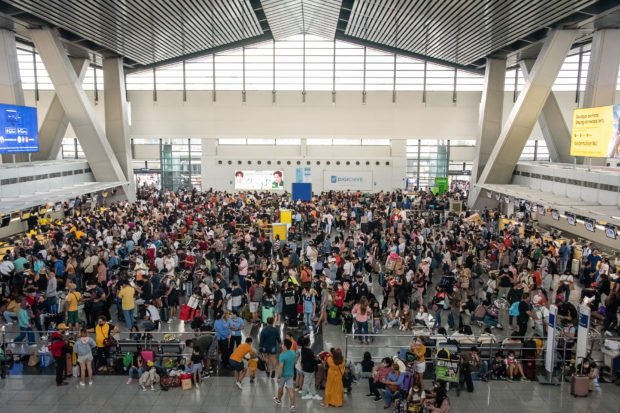Senate to start probe of Naia glitch while still in recess

Thousands of travelers were stranded at Philippine airports on January 1 after a “loss of communication” at the country’s busiest hub in Manila forced hundreds of flights to be canceled, delayed or diverted. (Photo by KEVIN TRISTAN ESPIRITU / AFP)
MANILA, Philippines — Demanding more answers and accountability for an epic fail as monstrous as the New Year’s Day airport shutdown, senators will start grilling concerned transport and aviation officials about the fiasco next week, even while still in recess.
“We can conduct hearings even during the (legislative) break,” Sen. Grace Poe, chair of the Senate committee on public services, told reporters on Wednesday as she announced that the first hearing will be on Jan. 12. The regular session resumes on Jan. 23.
Poe firmed up plans for the inquiry even as the Department of Transportation (DOTr) and the Civil Aviation Authority of the Philippines (Caap) said normal airport operations in the country, mainly at Ninoy Aquino International Airport, had been fully restored.
“[We are] allowing Caap and DOTr to normalize airport operations before conducting a hearing. By that time, key executives should not have an excuse not to attend,” said Poe.
Fund diversion?
Sen. Risa Hontiveros said the coming Senate probe must also tackle allegations that funds worth P13 billion meant for the modernization of Caap’s communications, navigation, surveillance and air traffic management system (CNS/ATM) were just diverted to “cosmetic projects” during the term of then Transportation Secretary Arthur Tugade.
Article continues after this advertisementThe allegation was first reported by the online news portal bilyonaryo.com.
Article continues after this advertisementReached for comment on Tuesday, Tugade dismissed the allegation as being “farthest from the truth.”
The former member of the Duterte Cabinet said he had “always instructed a backup” and “a redundancy plan” for the country’s CNS/ATM system.
He identified several DOTr officials—either past or present—who “cannot deny this.”
Possible corruption
He mentioned Manuel Antonio Tamayo, former transport undersecretary for aviation and airports; Danjun Lucas, now acting deputy director general for administration; Jim Sydiongco, former Caap director general; and Ricardo Banayat, Caap deputy director general.
“They recommended, monitored and implemented. Ask them,” Tugade said in a Viber message to the Inquirer.
“Given these competing claims (about the P13-billion funding), a thorough investigation must be undertaken to identify the (Jan. 1) incident’s proximate and the contributory causes,” Hontiveros said.
“It’s imperative to investigate allegations of funding delays and possible corruption in the establishment of the CNS/ATM system,” she said, and to “determine liabilities of government officials and private contractors.”
“While the DOTr has ruled out sabotage, the breakdown of the power source throws into question the capacity of our air traffic control system to withstand cyberattacks and hacking, and exposes our vulnerability to such hostile incursions,” she said. She said the Senate should also invite the private supplier of the CNS/ATM to check for violations of the terms in its performance guarantee, as examined by the Commission on Audit.
Cebu alternative
Hontiveros described as “mind-boggling” the government’s failure to come up with a backup plan especially since Caap had already informed President Marcos and his predecessor, Rodrigo Duterte, about the need to upgrade the “outdated” airport facilities.
In a phone interview, Alexander Cauguiran, former president and chief executive officer of the state-owned Clark International Airport Corp. (Ciac), said backup radar systems for international airports such as Clark International Airport (CRK) and the one in Mactan are needed, “at least to minimize inconvenience in the future.”
Cauguiran said all international airports in the country must procure their own air traffic management radar system to avoid the mass cancellation of flights should a similar breakdown happen in the future.
The CRK, as it is today, “cannot be used as an alternative to Naia because it is also within the range” of the current CNS/ATM, he explained.
According to Jose Victor Luciano, also a former Ciac president and CEO, setting up a CNS/ATM system today would cost around P15 billion.
For Darwin Cunanan, Ciac officer in charge, a backup system to be set up now “better be placed in Cebu,” because if problems again crop up in the capital “it is highly probable that Clark will also be affected because of its proximity to Manila.”
Joint probe pushed
At the House of Representatives, Deputy Minority Leader Bernadette Herrera suggested a joint probe by the House and the Senate, saying “we are interested in whether the lightning storms these past months affected the equipment involved in the outage.”
The House transportation committee chair, Rep. Romeo Acop, and the good governance and public accountability committee chair, Rep. Florida Robes, filed separate bills also seeking an inquiry.
“This is what the committee wants to know—accountability: where did it all go wrong, was this a ‘force majeure’ or an act resulting from negligence, and whose negligence?” said Robes, who was one of the inbound passengers inconvenienced by the airspace shutdown.
Robes noted that the current CNS/ATM was funded by a loan from the Japan International Cooperation Agency (Jica) in 2003 worth 22,049 million yen, but that it was inaugurated only in January 2018.
She said data from the Department of Budget and Management showed that the government continued to receive the loan package even in 2021.
Aside from the Jica loan, the 2017 national budget allotted P122,273,000 for the CNS/ATM project, she said.